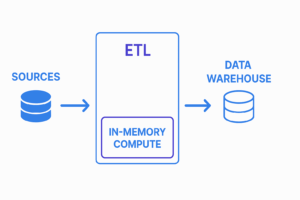Hello folks, IOblend here. Hope you are all keeping well.
There is one thing that has been bugging us recently, which led to the writing of this blog. While working on several data projects with some of our clients, we observed instances when data lineage had not been implemented as part of the solutions. In a couple of cases, data lineage was entirely overlooked, which raised our eyebrows.
Data lineage is paramount from the data auditing point of view. How else would you keep track of what is happening to your data throughout its lifecycle? What if your systems go down and the data becomes corrupted? How would you know what data generated spurious results down the line? You will really struggle to restore your data to the correct state if you do not know where the problem is.
The common reason for data lineage omission was the time pressure to deploy a new system. Delivering the system was considered a much higher priority than ensuring the data quality that fed it. We get it, designing and scripting data lineage across your entire dataflows and data estate can be a massive undertaking, especially under time and resource pressure.


However, data issues always come to bite you in the long run. Just from the security and reliability points of view, you absolutely must be on top of your data happenings. Data lineage gives you that ability. The more granular data lineage is, the easier your life will be when things go wrong with your data.
Inevitably, you will have to implement data lineage, but then someone will have to code it from scratch. Data lineage must go all the way across the data from the source to the end point and cover the data at the lowest level regardless of the types. It should be the same granularity for all stakeholders, so everyone works off the base baseline. You will then have a much greater confidence in your data estate.
Implementing data lineage is not a simple job. You need to set and build in data quality and monitoring policies for all dataflows. Depending on your resources, this can be a daunting task. It is much trickier to implement if you are doing live data streaming. There are some tools available on the market that can help you with the task, but you need to make sure they can work well with the rest of your data estate and give you sufficient granularity.
Since we have encountered data lineage issues on more than one occasion, we made data lineage an integral part of our solution. We do DataOps, and data lineage is DataOps. At IOblend, we made sure that the most granular data lineage is available to you ‘out-of-the-box’. It starts at record level with the raw data and maps the transformations all the way to the end target. Our process utilises the power of Apache Spark™ but requires no coding whatsoever on the user’s part. Just visually design your dataflow and data lineage is applied automatically, every time.
Once applied, you can trace data lineage via IOblend or any other analytical tool you may use at your data end points. No hassle. Your data citizens will always have the full confidence in the quality of their data.
IOblend – make you data estate state-of-the-art
Stay safe and catch you soon


PoC to Production: Accelerating AI Deployment with IOblend
PoC to Production: Accelerating AI Deployment with IOblend 💭 Did You Know? While a staggering 92% of companies are actively experimenting with Artificial Intelligence, a mere 1% ever achieve full maturity in deploying AI solutions at scale. The AI Production Journey A Proof of Concept (PoC) in AI serves as a small-scale, experimental project designed

AI in Healthcare with Smart Data Pipelines
AI in Healthcare: Powering Progress with Smart Data Pipelines 💉 Did you know? Hospitals in the UK alone produce an astonishing 50 petabytes of data per year, more than double the data managed by the US Library of Congress in 2022! What are Data Pipelines for AI Model Training? In the context of healthcare, this means

The Urgency of Now: Real-Time Data in Analytics
The Urgency of Now: Real-Time Data in Analytics ✈️ Did you know? Every minute of delay in airline operations can cost as much as £100 per minute for a single aircraft. With thousands of flights daily, those minutes add up fast. Just like in aviation, in data analytics, even small delays can lead to big

Still Confused in 2025? AI, ML & Data Science Explained
Still Confused in 2025? AI, ML & Data Science Explained…finally It seems everyone in business circles talks about these days. AI will solve all our business challenges and make/save us a ton of money. AI will replace manual labour with clever agents. It will change the world and our business will be at the forefront

Beyond Spreadsheets: The CFO’s Path to Data-Driven Decisions
Beyond Spreadsheets: The CFO’s Path to Data-Driven Decisions 📊 Did you know? Companies leveraging data-driven insights consistently report a significant uplift in profitability – often exceeding 20%. That’s not just a marginal gain; it’s a game-changer. The Data-Driven CFO The modern Chief Financial Officer operates in a world awash with data. No longer solely focused

Shift Left: Unleashing Data Power with In-Memory Processing
Mind the Gap: Bridging Data Shift Left: Unleashing Data Power with In-Memory Processing 💻 Did you know? Organisations that implement shift-left strategies can experience up to a 30% reduction in compute costs by cleaning data at the source. The Essence of Shifting Left Shifting data compute and governance “left” essentially means moving these processes closer

